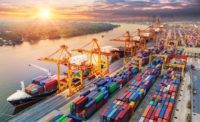From the Editor
Climate-Driven Extreme Events and the Supply Chain
Climate-related issues, such as El Niño weather events and falling water levels in major waterways, are creating problems for global shipping.

My father was the son of an Idaho farmer. And while he left the farm to help run universities as a profession, one thing that did not leave him was the need to track the weather. He was a man concerned with the weather. He carefully tracked it in each of the cities where his five children lived, and then cities where the grandkids lived. With his large family spread out across the globe, my father had a lot of weather to watch. He was not mistaken in his concern. Today, as we track air quality caused by wildfires in Canada, watch the impact of a rare tropical storm hit Southern California, or see the devastation caused by wildfires in Maui, we are all turning into global weather trackers. If we are not tracking the weather, maybe we should.
In a recently published article by CNBC, reporter Sam Meredith outlined the ways that increasing climate-driven extreme weather events are impacting global shipping routes. There is additional worry that El Niño conditions have the potential to make the situation even worse. According to some estimates, between 80 to 90 percent of goods traded in the world are transported by sea, and disruptions, either by political entities or by natural conditions, can cause serious problems for business.
Currently, forecasters expect a greater than 95% chance that El Niño conditions will continue through the winter. According to a blog on NOAA’s website, impacts of El Niño on global climate include “more rain and storms across the southern tier of the United States, southeastern South America, around the horn of Africa, and eastern Asia.” Additionally, from December until February, drier conditions surface in the Maritime continent/Indonesia, southeastern Africa, and northeastern South America. And in June through August, drier conditions through the Caribbean, Indonesia, India, northern South America, parts of Central America, and eastern Australia can happen.
So, what does that have to do with global shipping? Well, let’s look at the critical shipping route through the Panama Canal as an example. In early August, the Panama Canal Authority announced that in response to drought conditions that it characterized as having “no historical precedence,“ it is cutting down the number of vessels transitioning through the canal, creating a backup of ships. Additionally, the authority is reducing by six feet the draft the canal will maintain throughout 2023 and into 2024. In Meredith’s CNBC article, he interviewed a representative from Danish shipping company Maersk who said that the water levels and restrictions on the canal caused his company to load fewer containers onto ships to achieve the weight reduction required by the restrictions. So, fewer ships carrying less cargo are going through a key waterway for global shipping routes.
Other climate-related issues impacting global shipping mentioned in the CNBC article include: falling water levels on the Rhine River in Germany impacting shipping in the European Union and a study that found two major risks for the Suez Canal: extreme heat along the entire canal and coastal inundation — where a rise in sea levels floods infrastructure. The Suez Canal study listed a “handful of key waterways across the world” that, if block by either “deliberate political,” accident, or climate-related events, would significantly impact the supply chain.
In reading about this, some key points jumped out: the need to identify points of failure, build resiliency within systems, and become better at rapidly adapting to changing circumstances. From what I have observed since becoming the editor of ASI, the adhesive and sealant industry is keenly aware of these key points. The time when thinking of the supply chain as an element in the background of a business that simply functions without much thought has passed, and it is not coming back.
This is one reason why the September edition of ASI is relevant to your business! In this issue, we offer our annual distributor roundtable article and our Distributor Directory, which is a key resource for information about companies within the distribution space. And be sure to read these articles as well: the use of nitrogen in UV curing by Smith Corona, the first of a three-part series on static mixing by medmix, an article outlining the value of acrylic hot melt PSAs by Bostik, the use of solventless laminating adhesives in packaging applications by ChemPoint, and a very interesting products focus by Shurtape about an app for scannable tapes and labels.
Looking for a reprint of this article?
From high-res PDFs to custom plaques, order your copy today!





